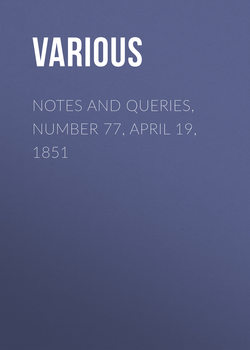Читать книгу Notes and Queries, Number 77, April 19, 1851 - Various - Страница 2
Notes
STRANGE APPEARANCES IN THE SKY
ОглавлениеStrange appearances in the sky have not been without their ominous signification from the time that the greater and lesser lights were placed there at the creation, to the rainbow after the Deluge; and onward to the "star in the east" which announced our Saviour's birth, and the "light from heaven" which accompanied St. Paul's conversion. But the question is, whether there has since been any meaning in other like celestial illuminations? Some historical credit is claimed for the fiery sword, and armies fighting in the air, which preceded the siege of Jerusalem: for the cross of the Emperor Constantine: for the bow about the sun seen by Augustus Cæsar, when he took possession of the Roman empire: and for stars, or other heavenly lights, which have seemed to herald the births or deaths of illustrious personages. But are these stories to be believed? and, if they are, where is the line of credibility to be drawn? People cannot come together, and talk either on this subject, or on that of ghosts, but every one "hath a revelation, hath an interpretation." The poet, walking on the mountains, looked into the sky, and
"The appearance, instantaneously disclosed,
Was of a mighty city—boldly say
A wilderness of building, sinking far,
And self-withdrawn, into a wondrous depth,
Far sinking into splendour—without end?"
The two following extracts are from private letters now before me. The first account was written in 1825 by a physician, still alive, and who at the time read an account of what he had seen at a meeting of the Plinian Society. He says,
"I last evening read a paper upon an extraordinary appearance of letters, formed by the clouds, seen by a Mr. T. and myself. We had also with us two little boys, one nine, the other eleven years of age, who were able to make out each letter equally with ourselves. These children were at the time walking some distance behind us: but, upon their coming up, and being shown the letters, they read them without having heard any observation of ours respecting them. We saw them for about two minutes, when they gradually changed their form—each letter changing its perpendicular for a horizontal position, and at length the whole becoming converted into that form of cloud denominated cirro-stratus. I will endeavour to give you a faint idea of the appearance, by forming the letters as well as my memory will enable me. I make no comment upon the words themselves, as they are too extraordinary for observation of any kind. It was upon the 12th of last month: several showers had fallen in the course of the day, but the afternoon was fine. The time seven in the evening. The letters were formed upon a fine blue surface, having no other clouds near them, except very small ones, which tended much to heighten the effect of the whole.
(ETERNAL)
(MILLENNIUM)
"You will observe several deficiencies in the letters of the first word, viz. in the first 'E;' also in the 'N,' the second part being short; and a slight defect in the letter 'A.' With respect to the second word, the first six letters were very perfect: the others, with the exception of the 'M,' mere strokes; but in number sufficient to make up the word: and they had the appearance of having been perfect. I can assure you they were anything but obscure, and required very little stretch of the imagination. In the first word the letters were equidistant and beautifully uniform. The second word was not quite straight, being curved towards its termination. This appeared to me to arise from the change of position which the letters were undergoing, as before stated."
My other extract is from a letter written in 1851. The scene to which it refers is a sick chamber occupied by an octogenarian grandmother, who is in extremis. Her daughter, who writes the account, is present, together with a grandchild, who is nearly eleven years old. The nurse has left the room.
"We afterwards stood by poor grandmamma's fire, and then we sat at her window to see the moon rise. There were many clouds about it, and directly under it was the most marked figure of our Saviour on the cross. The head was concealed in light, but the arms were outstretched, and the body quite distinct. M. saw it too, and said, 'How appropriate, aunt, for the beginning of Lent!' She has never alluded to it since, nor, of course, have I; nor do I think any more of it, than that there it was: and there is something happy in the fancy, at all events, for it shone on her dying bed."
As you admit folk lore into "Notes and Queries," also well-attested anecdotes, although these may not absolutely conduce to the advancement of learning or art, perhaps you will receive this paper for the amusement of those who, like myself, feel an interest in anything which takes us a little out of the hardware facts of "the age we live in."
Alfred Gatty.
Ecclesfield.
